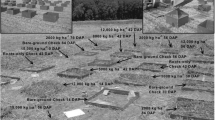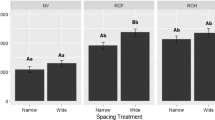Abstract
The use of allelopathic cover crops in reduced tillage cropping systems may provide an ecologically sound and environmentally safe management strategy for weed control. Growers often plant winter rye (Secale cereale L.) for increased soil organic matter and soil protection. Spring-planted living rye reduced weed biomass by 93% over plots without rye. Residues of fall-planted/spring-killed rye reduced total weed biomass over bare-ground controls. Rye residues also reduced total weed biomass by 63% when poplar excelsior was used as a control for the mulch effect, suggesting that allelopathy, in addition to the physical effects of the mulch, did contribute to weed control in these systems. In greenhouse studies, rye root leachates reduced tomato dry weight by 25–30%, which is additional evidence that rye is allelopathic to other plant species.
Similar content being viewed by others
References
Chapman, H.D. (ed.). 1966. Dignostic Criteria for Plants and Soils—Organic Soil Toxins. University of California: Division of Agricultural Sciences, pp. 533–569.
Chou, C.H., andPatrick, Z.A. 1976. Identification and phytotoxic activity of compounds produced during decomposition of corn and rye residues in soil.J. Chem. Ecol. 2:369–387.
DeFrank, J. 1979. Weed and vegetable response to allelopathic influences in no-tillage plantings. Master's thesis, Michigan State University, Department of Horticulture, 95 pp.
Ellis, J.R., andMcCalla, T.M. 1973. Effect of patulin and method of application on growth stages of wheat.Appl. Microbiol. 25:562–566.
Foy, C.L., Witt, W.H., andHale, M.G. 1971. Root exudation of plant growth regulators, pp. 75–85. U.S. National Commission for International Biological Program (eds.). Biochemical Interactions among Plants. National Academy of Science, Washington, D.C.
Hill, H.H. 1926. Decomposition of organic matter in soil.J. Agric. Res. 33:77–99.
Kimber, R.W.L. 1973. Phytotoxicity from plant residues II. The effect of time of rotting of straw from some grasses and legumes on the growth of wheat seedlings.Plant Soil 38:347–361.
McCalla, T.M., andDuley, F.L. 1948. Stubble mulch studies. Effect of sweet clover extract on corn germination.Science 108:163.
McCalla, T.M., andDuley, F.L. 1949. Stubble mulch studies: III. Influence of soil microorganisms and crop residues on the germination, growth, and direction of root growth of corn seedlings.Soil. Scid. Soc. Am. Proc. 14:196–199.
McCalla, T.M., andHaskins, F.A. 1964. Phytotoxic substances from soil microorganisms and crop residues.Bacterial. Rev. 28:181–207.
Norstadt, F.A.,andMcCalla, T.M. 1963. Phytotoxic substances from a species ofPenicillium.Science. 140:401–411.
Osvald, H. 1953. On antagonism between plants, pp. 167–171. In H. Osvald and E. Åberg (eds.).Proc. (7th)Intern. Botanical Congress Stockholm (1950). Almqvist and Wiksell, Stockholm.
Overland, L. 1966. The role of allelopathic substances in the “smother crop” barley.Am. J. Bot. 53:423–432.
Patrick, Z.A. 1971. Phytotoxic substances associated with the decomposition in soil of plant residues.Soil Sci. 111:13–18.
Patrick, S.A., andKoch, L.W. 1958. Inhibition of respiration, germination, and growth of substances arising during the decomposition of certain plant residues in the soil.Can. J. Bot. 36:621–647.
Phillips, S.H., andYoung, H.M., Jr. 1973. No Tillage Farming. Reiman Assoc., Milwaukee, Wisconsin, 224 pp.
Rice, E.L. 1974.Allelopathy. Academic Press, New York, 353 pp.
Rice, E.L. 1979. Allelopathy—An update.Bot. Rev. 45:15–109.
Rovira, A.D. 1969. Plant root exudates.Bot. Rev. 35:35–59.
Rutherford, I. 1976. Problems of straw disposal.Outlook Agric. 8:248–249.
Spomer, L.A. 1975. Small soil containers as experimental tools: Soil water relations.Common Soil Sci. Plant Anal. 6(1):21–26.
Spomer, L.A. 1976. Container soils are different.Ill. State Flor. Assoc. Bull. 365.
Tukey, H.B., Jr. 1969. Implications of allelopathy in agricultural plant science.Bot. Rev. 35:1–16.
Whittaker, R.H. 1975. Communities and Ecosystems, 2nd ed. Macmillan, New York, 358 pp.
Young, H.M. 1973. ‘No-tillage’ farming in the U.S.—its profit and potential.Outlook Agri. 7:143–148.
Author information
Authors and Affiliations
Additional information
Journal Article No. 10712 of the Michigan Agricultural Experiment Station. Supported by United States Department of Agriculture Competition Grant No. 78-59-2261-0-1-060-1.
Rights and permissions
About this article
Cite this article
Barnes, J.P., Putnam, A.R. Rye residues contribute weed suppression in no-tillage cropping systems. J Chem Ecol 9, 1045–1057 (1983). https://doi.org/10.1007/BF00982210
Received:
Revised:
Issue Date:
DOI: https://doi.org/10.1007/BF00982210




